Smart Monitoring and Controlling of Appliances Using LoRa Based IoT System
Abstract
1. Introduction
- The research work has designed and developed a smart IoT system with ESP32 module and LoRa wireless communication module for long range communication (3 km to 12 km) via transmitting and receiving data at low power consumption in order to overcome the limitation of existing short distance (10 m–100 m) communication technologies.
- A mobile app has been developed to monitor and control appliances with a number of features and sub-functionalities.
- Functionality tests were conducted in different simulated environments using different sensors to assess the system’s performance.
2. Smart Automation System Design
2.1. Systems Architecture
2.2. Working Principle of the Proposed System
2.3. Hardware Description
2.3.1. LoRa Module
2.3.2. ESP32 Microprocessor
2.3.3. Sensors
2.3.4. Relay
2.4. Sender End Circuit Diagram
2.5. Receiver End Circuit Diagram
2.6. App Development
3. Results and Discussions
3.1. Android App User Tests
3.2. Smart Home or Institute Application Cases
- (1)
- In the first case, temperature and humidity were measured by the sensor and monitored by the developed mobile app in order to check the room temperature so that appropriate appliances can be turned ON or OFF remotely.
- (2)
- In the second case, distance of fire from the flame sensor were varied to observe whether the sensor used in the proposed system can detect the fire or not and to send the message to the app for drawing attention of the system user.
- (3)
- In the last case, the proposed system used a servomotor, ESP32 module and a relay to control switches of the appliances (i.e., fan, AC and door) by toggling the ON/OFF button in the android app. Then, the LoRa module transmitted signal to the target appliances for controlling their operations.
3.2.1. Case 1: Monitoring Temperature and Humidity
3.2.2. Case 2: Fire Detection
3.2.3. Case 3: Controlling Switches
3.3. General Discussions
3.3.1. Comparative Analysis
3.3.2. System Development
3.3.3. Key Performance Metrices Analysis
3.3.4. Security Analysis
3.3.5. Further Development Opportunities
4. Conclusions and Future Work
Author Contributions
Funding
Institutional Review Board Statement
Informed Consent Statement
Data Availability Statement
Acknowledgments
Conflicts of Interest
References
- MacGillivray, C.; Torchia, M.; Bisht, A.; Kalal, M.; Leung, J.; Membrila, R.; Siviero, A.; Wallis, N.; Torisu, Y. Worldwide Internet of Things Forecast Update. IDC Research: 2020. pp. 2019–2023. Available online: https://www.idc.com/getdoc.jsp?containerId=US45373120 (accessed on 15 November 2020).
- Tankovska, H. Internet of Things (IoT) Spending Worldwide 2023. Available online: https://www.statista.com/statistics/668996/worldwide-expenditures-for-the-internet-of-things (accessed on 28 September 2020).
- Hamdan, O.; Shanableh, H.; Zaki, I.; Al-Ali, A.R.; Shanableh, T. IoT-Based Interactive Dual Mode Smart Home Automation. In Proceedings of the IEEE International Conference on Consumer Electronics (ICCE), Las Vegas, NV, USA, 11–13 January 2019; pp. 1–2. [Google Scholar]
- Maksudjon, U.; Gregoretti, F. Design and implementation of a LoRa based wireless control for drip irrigation systems. In Proceedings of the International Conference on Robotics and Automation Engineering (ICRAE), Shanghai, China, 29–31 December 2017; pp. 248–253. [Google Scholar] [CrossRef]
- Lora Alliance. Available online: https://www.lora-alliance.org/ (accessed on 25 September 2020).
- Shahjalal, M.; Hasan, M.K.; Islam, M.M.; Alam, M.M.; Ahmed, M.F.; Jang, Y.M. An Overview of AI-Enabled Remote Smart-Home Monitoring System Using LoRa. In Proceedings of the International Conference on Artificial Intelligence in Information and Communication (ICAIIC), Fukuoka, Japan, 19–21 February 2020; pp. 510–513. [Google Scholar]
- Zhao, W.; Lin, S.; Han, J.; Xu, R.; Hou, L. Design and implementation of smart irrigation system based on LoRa. In Proceedings of the IEEE Globecom Workshops (GC Wkshps), Singapore, 4–8 December 2017; pp. 1–6. [Google Scholar]
- Cong, T.D.; Truvant, T.C.; Bui, T.D. Design of automatic irrigation system for greenhouse based on LoRa technology. In Proceedings of the International Conference on Advanced Technologies for Communications (ATC), Ho Chi Minh City, Vietnam, 18–20 October 2018; pp. 72–77. [Google Scholar] [CrossRef]
- Patil, S.; Ashokkumar, P.S.; Patil, P.B. Smart Home System using Internet of Things over WiFi. Int. J. Latest Technol. Eng. Manag. Appl. Sci. (IJLTEMAS) 2017, VI, 2278–2540. [Google Scholar]
- Abu, M.A.; Faris, W.M.; Kamarulzaman, W. Development of home automation systems by using android apps. ARPN J. Eng. Appl. Sci. 2018, 13, 2809–2814. [Google Scholar]
- Raza, U.; Kulkarni, P.; Sooriyabandara, M. Low power wide area networks: An overview. IEEE Commun. Surv. Tutor. 2017, 19, 855–873. [Google Scholar] [CrossRef]
- More, A.; Abhishek, S.M.; Wadkar, G.A. Improvised Home Automation System with Incorporation of WSN and IoT. Int. J. Sci. Res. 2017, 5, 2321-0613. [Google Scholar]
- Haxhibeqiri, J.; Abeele, F.V.D.; Moerman, I.; Hoebeke, J. LoRa scalability: A simulation model based on interference measurements. Sensors 2017, 17, 1193. [Google Scholar] [CrossRef]
- Pasetti, M.; Ferrari, P.; Silva, D.R.C.; Silva, I.; Sisinni, E. On the Use of LoRaWAN for the Monitoring and Control of Distributed Energy Resources in a Smart Campus. Appl. Sci. 2020, 10, 320. [Google Scholar] [CrossRef]
- Rahman, W.; Hossain, E.; Islam, R.; Rashid, H.A.; Alam, N.A.; Hasan, M. Real-time and Low-cost IoT based farming using raspberry Pi. Indones. J. Electr. Eng. 2020, 17, 197–204. [Google Scholar] [CrossRef]
- Wang, S.; Chen, Y.; Chen, T.; Chang, C.; Cheng, Y.; Hsu, C.; Lin, Y. Performance of LoRa-based IoT applications on campus. In Proceedings of the IEEE 86th Vehicular Technology Conference (VTC-Fall), Toronto, ON, Canada, 24–27 September 2017. [Google Scholar] [CrossRef]
- Behera, S.; Saha, A.K.; Kumar, D.; Polai, J. Home Automation control system using SMS. Int. Res. J. Eng. Technol. (IRJET) 2017, 4, 1779–1783. [Google Scholar]
- Rathi, K.; Patil, D.; Bhavsar, S.; Jadhav, K.; Thakur, S.V. Gesture Human-Machine Interface (GHMI) in Home Automation. Int. Res. J. Eng. Technol. (IRJET) 2017, 4, 2607–2611. [Google Scholar]
- Mattia, R.; Ferrari, P.; Flammini, A.; Sisinni, E.; Gidlund, M. Using LoRa for industrial wireless networks. In Proceedings of the IEEE 13th International Workshop on Factory Communication Systems (WFCS), Trondheim, Norway, 31 May–2 June 2017; pp. 1–4. [Google Scholar] [CrossRef]
- Lee, K.M.; Teng, W.G.; Hou, T.W. Point-n-Press: An Intelligent Universal Remote-Control System for Home Appliances. IEEE Trans. Autom. Sci. Eng. 2016, 13, 1308–1317. [Google Scholar] [CrossRef]
- Sung, W.; Hsiao, S.; Wang, S.; Chou, J. LoRa-based Internet of Things Secure Localization System and Application. In Proceedings of the International Conference on Systems, Man and Cybernetics (SMC), Bari, Italy, 6–9 October 2019; pp. 1672–1677. [Google Scholar] [CrossRef]
- Beliatis, M.J.; Mansour, H.; Nagy, S.; Aagaard, A.; Presser, M. Digital waste management using LoRa network a business case from lab to fab. In Proceedings of the IEEE Global Internet of Things Summit (GIoTS), Bilbao, Spain, 4–7 June 2018; pp. 1–6. [Google Scholar] [CrossRef]
- Zhou, W.; Tong, Z.; Dong, Z.Y.; Wang, Y. LoRa-Hybrid: A LoRaWAN Based Multihop Solution for Regional Microgrid. In Proceedings of the 4th IEEE International Conference on Computer and Communication Systems (ICCCS), Singapore, 23–25 February 2019; pp. 650–654. [Google Scholar] [CrossRef]
- Pasolini, G.; Buratti, C.; Feltrin, L.; Zabini, F.; De Castro, C.; Verdone, R.; Andrisano, O. Smart City Pilot Projects Using LoRa and IEEE802.15.4 Technologies. Sensors 2018, 18, 1118. [Google Scholar] [CrossRef]
- Gambi, E.; Montanini, L.; Pigini, D.; Ciattaglia, G.; Spinsante, S. A home automation architecture based on LoRa technology and Message Queue Telemetry Transfer protocol. Int. J. Distrib. Sens. Netw. 2018, 14, 1550147718806837. [Google Scholar] [CrossRef]
- Basford, P.J.; Bulot, F.M.J.; Apetroaie-Cristea, M.; Cox, S.J.; Ossont, S.J. LoRaWAN for Smart City IoT Deployments: A Long-Term Evaluation. Sensors 2020, 20, 648. [Google Scholar] [CrossRef]
- Bravo-Arrabal, J.; Fernandez-Lozano, J.J.; Serón, J.; Gomez-Ruiz, J.A.; García-Cerezo, A. Development and Implementation of a Hybrid Wireless Sensor Network of Low Power and Long Range for Urban Environments. Sensors 2021, 21, 567. [Google Scholar] [CrossRef]
- Xu, W.; Zhang, J.; Kim, J.Y.; Huang, W.; Kanhere, S.S.; Jha, S.K.; Hu, W. The design, implementation, and deployment of a smart lighting system for smart buildings. IEEE Internet Things J. 2019, 6, 7266–7281. [Google Scholar] [CrossRef]
- Xu, W.; Kim, J.Y.; Huang, W.; Kanhere, S.S.; Jha, S.K.; Hu, W. Measurement, characterization, and modeling of lora technology in multifloor buildings. IEEE Internet Things J. 2020, 7, 298–310. [Google Scholar] [CrossRef]
- Kim, K.; Li, S.; Heydariaan, M.; Smaoui, N.; Gnawali, O.; Suh, W.; Suh, M.J.; Kim, J.I. Feasibility of LoRa for Smart Home Indoor Localization. Appl. Sci. 2021, 11, 415. [Google Scholar] [CrossRef]
- Liang, R.; Zhao, L.; Wang, P. Performance Evaluations of LoRa Wireless Communication in Building Environments. Sensors 2020, 20, 3828. [Google Scholar] [CrossRef]
- Yasmin, R.; Mikhaylov, K.; Pouttu, A. LoRaWAN for Smart Campus: Deployment and Long-Term Operation Analysis. Sensors 2020, 20, 6721. [Google Scholar] [CrossRef] [PubMed]
- Andrade, R.O.; Yoo, S.G. A comprehensive study of the use of LoRa in the development of smart cities. Appl. Sci. 2019, 9, 4753. [Google Scholar] [CrossRef]
- Tosi, J.; Taffoni, F.; Santacatterina, M.; Sannino, R.; Formica, D. Performance evaluation of Bluetooth low energy: A systematic review. Sensors 2017, 17, 2898. [Google Scholar] [CrossRef]
- Gislason, D. Zigbee Wireless Networking; Newnes: Oxford, UK, 2008. [Google Scholar]
- Vejlgaard, B.; Lauridsen, M.; Nguyen, H.; Kovács, I.Z.; Mogensen, P.; Sorensen, M. Coverage and capacity analysis of sigfox, lora, gprs, and nb-iot. In Proceedings of the IEEE 85th Vehicular Technology Conference (VTC Spring), Sydney, Australia, 4–7 June 2017; pp. 1–5. [Google Scholar] [CrossRef]
- Lauridsen, M.; Nguyen, H.; Vejlgaard, B.; Kovács, I.Z.; Mogensen, P.P.; Sorensen, M. Coverage comparison of GPRS, NB-IoT, LoRa, and SigFox in a 7800 km² area. In Proceedings of the IEEE 85th Vehicular Technology Conference (VTC Spring), Sydney, Australia, 4–7 June 2017; pp. 1–5. [Google Scholar] [CrossRef]
- Sinha, R.S.; Wei, Y.; Hwang, S.H. A survey on LPWA technology: LoRa and NB-IoT. ICT Express 2017, 3, 14–21. [Google Scholar] [CrossRef]
- Sales Mendes, A.; Jiménez-Bravo, D.M.; Navarro-Cáceres, M.; Reis Quietinho Leithardt, V.; Villarrubia González, G. Multi-Agent Approach Using LoRaWAN Devices: An Airport Case Study. Electronics 2020, 9, 1430. [Google Scholar] [CrossRef]
- Islam, R.; Rahman, M.W.; Rubaiat, R.; Hasan, M.M.; Reza, M.M.; Rahman, M.M. LoRa and server-based home automation using the internet of things (IoT). J. King Saud Univ. Comput. Inf. Sci. 2021. [Google Scholar] [CrossRef]
- Ali, A.I.; Partal, S.Z.; Kepke, S.; Partal, H.P. Zigbee and LoRa based wireless sensors for smart environment and IoT applications. In Proceedings of the 2019 1st Global Power, Energy and Communication Conference (GPECOM), Nevsehir, Turkey, 12–15 June 2019; pp. 19–23. [Google Scholar]
- Souifi, J.; Bouslimani, Y.; Ghribi, M.; Kaddouri, A.; Boutot, T.; Abdallah, H.H. Smart Home Architecture based on LoRa Wireless Connectivity and LoRaWAN® Networking Protocol. In Proceedings of the 2020 1st International Conference on Communications, Control Systems and Signal Processing (CCSSP), El Oued, Algeria, 16–17 May 2020; pp. 95–99. [Google Scholar]
- Lousado, J.P.; Antunes, S. Monitoring and Support for Elderly People Using LoRa Communication Technologies: IoT Concepts and Applications. Future Internet 2020, 12, 206. [Google Scholar] [CrossRef]
- Mikhaylov, K.; Petaejaejaervi, J.; Haenninen, T. Analysis of capacity and scalability of the LoRa low power wide area network technology. In Proceedings of the European Wireless 2016 22nd European Wireless Conference, Oulu, Finland, 18–20 May 2016; pp. 1–6. [Google Scholar]
- Yousuf, A.M.; Rochester, E.M.; Ousat, B.; Ghaderi, M. Throughput, coverage and scalability of LoRa LPWAN for internet of things. In Proceedings of the IEEE/ACM 26th International Symposium on Quality of Service (IWQoS), Banff, AB, Canada, 4–6 June 2018; pp. 1–10. [Google Scholar]
- Lavric, A.; Popa, V. Internet of things and LoRa™ low-power wide-area networks: A survey. In Proceedings of the IEEE International Symposium on Signals, Circuits and Systems (ISSCS), Iași, Romania, 13–14 July 2017; pp. 1–5. [Google Scholar]
- Wu, F.; Wu, T.; Yuce, M.R. An Internet-of-Things (IoT) Network System for Connected Safety and Health Monitoring Applications. Sensors 2018, 19, 21. [Google Scholar] [CrossRef] [PubMed]
- Haxhibeqiri, J.; Karaagac, A.; Van den Abeele, F.; Joseph, W.; Moerman, I.; Hoebeke, J. LoRa indoor coverage and performance in an industrial environment: Case study. In Proceedings of the 22nd IEEE International Conference on Emerging Technologies and Factory Automation (ETFA), Iasi, Romania, 13–14 July 2017; pp. 1–8. [Google Scholar]
- Sundaram, J.P.S.; Du, W.; Zhao, Z. A Survey on LoRa Networking: Research Problems, Current Solutions, and Open Issues. IEEE Commun. Surv. Tutor. 2020, 22, 371–388. [Google Scholar] [CrossRef]
- Mekki, K.; Bajic, E.; Chaxel, F.; Meyer, F. A comparative study of LPWAN technologies for large-scale IoT deployment. ICT Express 2019, 5, 1–7. [Google Scholar] [CrossRef]
- Devalal, S.; Karthikeyan, A. LoRa technology-an overview. In Proceedings of the Second International Conference on Electronics, Communication and Aerospace Technology (ICECA), Coimbatore, India, 29–31 March 2018; pp. 284–290. [Google Scholar]
- Sendra, S.; García, L.; Lloret, J.; Bosch, I.; Vega-Rodríguez, R. LoRaWAN Network for Fire Monitoring in Rural Environments. Electronics 2020, 9, 531. [Google Scholar] [CrossRef]
- Aras, E.; Ramachandran, G.S.; Lawrence, P.; Hughes, D. Exploring the security vulnerabilities of LoRa. In Proceedings of the 3rd IEEE International Conference on Cybernetics (CYBCONF), Exeter, UK, 21–23 June 2017; pp. 1–6. [Google Scholar]
- Flores-Vergara, A.; Inzunza-González, E.; García-Guerrero, E.E.; López-Bonilla, O.R.; Rodríguez-Orozco, E.; Hernández-Ontiveros, J.M.; Cárdenas-Valdez, J.R.; Tlelo-Cuautle, E. Implementing a Chaotic Cryptosystem by Performing Parallel Computing on Embedded Systems with Multiprocessors. Entropy 2019, 21, 268. [Google Scholar] [CrossRef]
- Tlelo-Cuautle, E.; Díaz-Muñoz, J.D.; González-Zapata, A.M.; Li, R.; León-Salas, W.D.; Fernández, F.V.; Guillén-Fernández, O.; Cruz-Vega, I. Chaotic Image Encryption Using Hopfield and Hindmarsh–Rose Neurons Implemented on FPGA. Sensors 2020, 20, 1326. [Google Scholar] [CrossRef] [PubMed]
- Jebril, A.H.; Sali, A.; Ismail, A.; Rasid, M.F.A. Overcoming Limitations of LoRa Physical Layer in Image Transmission. Sensors 2018, 18, 3257. [Google Scholar] [CrossRef] [PubMed]
- García-Guerrero, E.E.; Inzunza-González, E.; López-Bonilla, O.R.; Cárdenas-Valdez, J.R.; Tlelo-Cuautle, E. Randomness improvement of chaotic maps for image encryption in a wireless communication scheme using PIC-microcontroller via Zigbee channels. Chaos Solitons Fractals 2020, 133, 109646. [Google Scholar] [CrossRef]
- Adelantado, F.; Vilajosana, X.; Tuset-Peiro, P.; Martinez, B.; Melia-Segui, J.; Watteyne, T. Understanding the limits of LoRaWAN. IEEE Commun. Mag. 2017, 55, 34–40. [Google Scholar] [CrossRef]
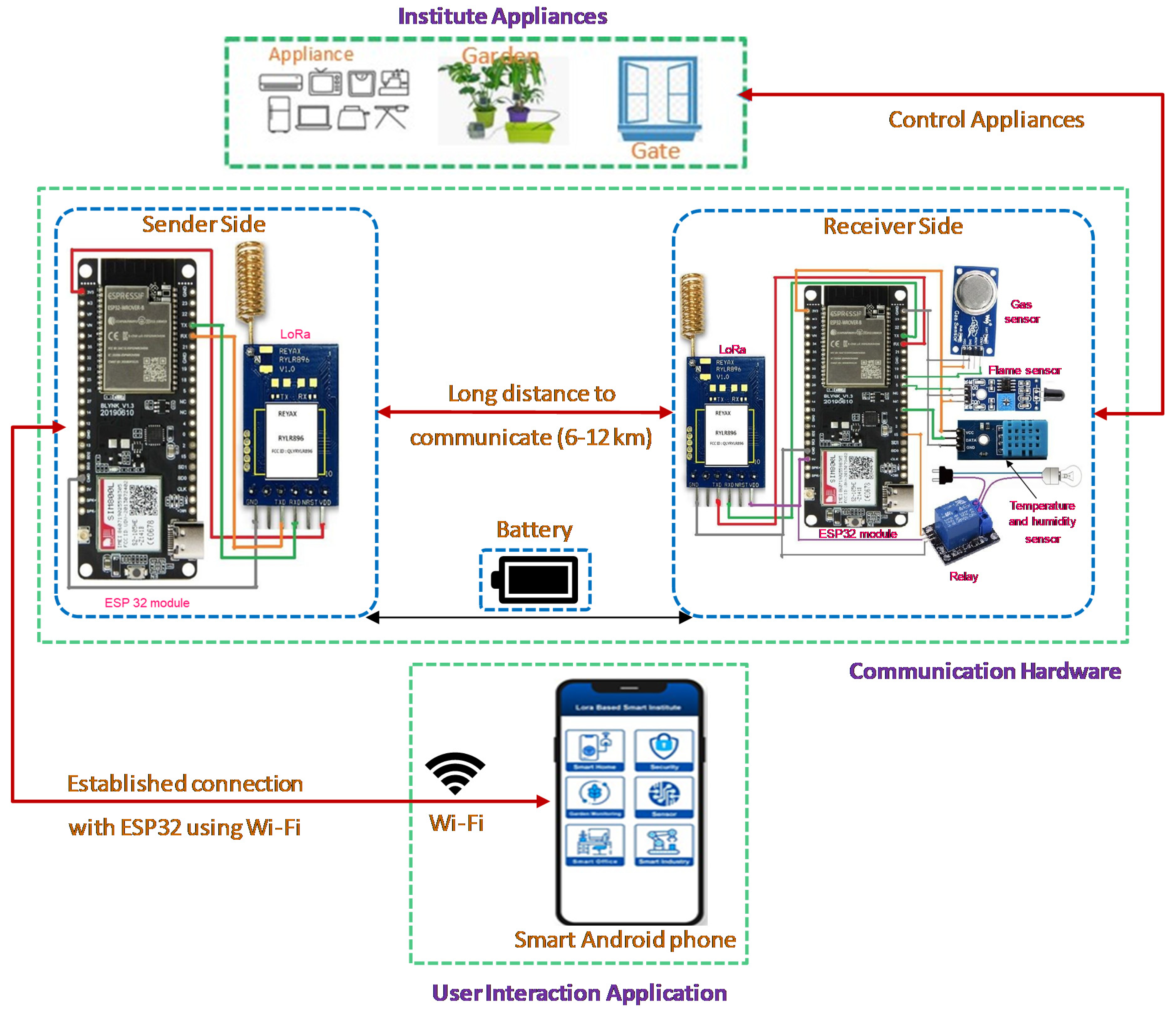
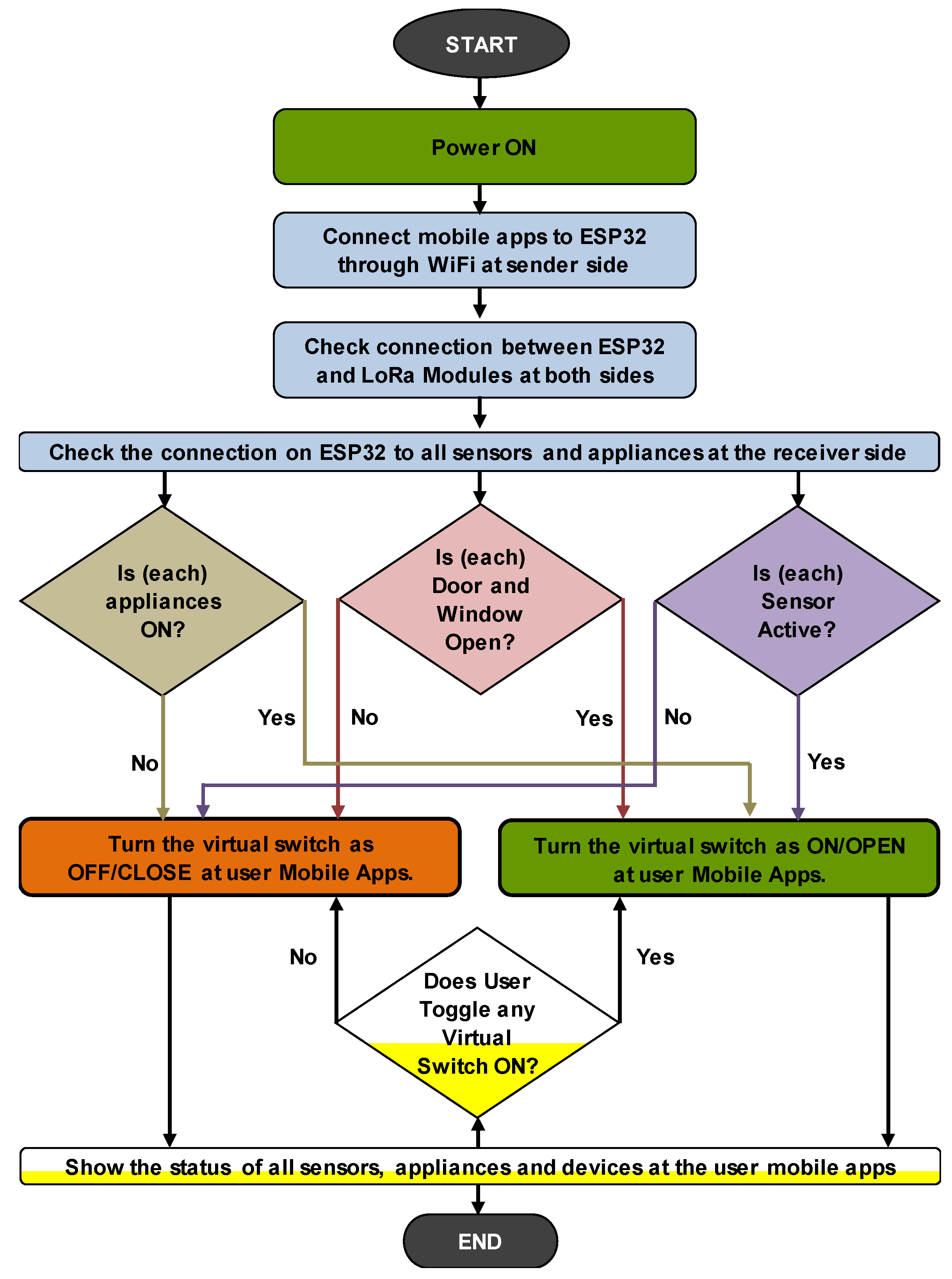
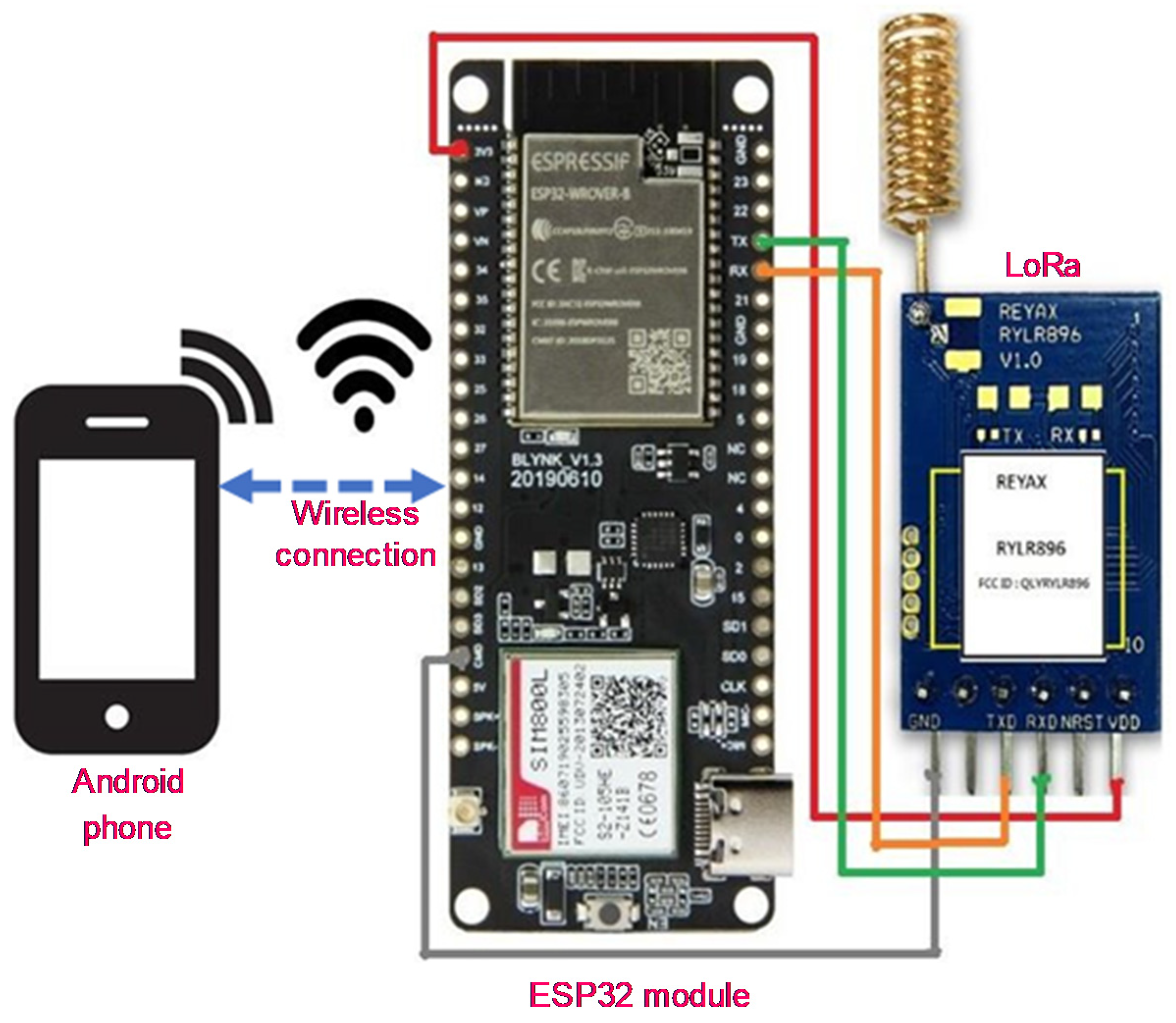
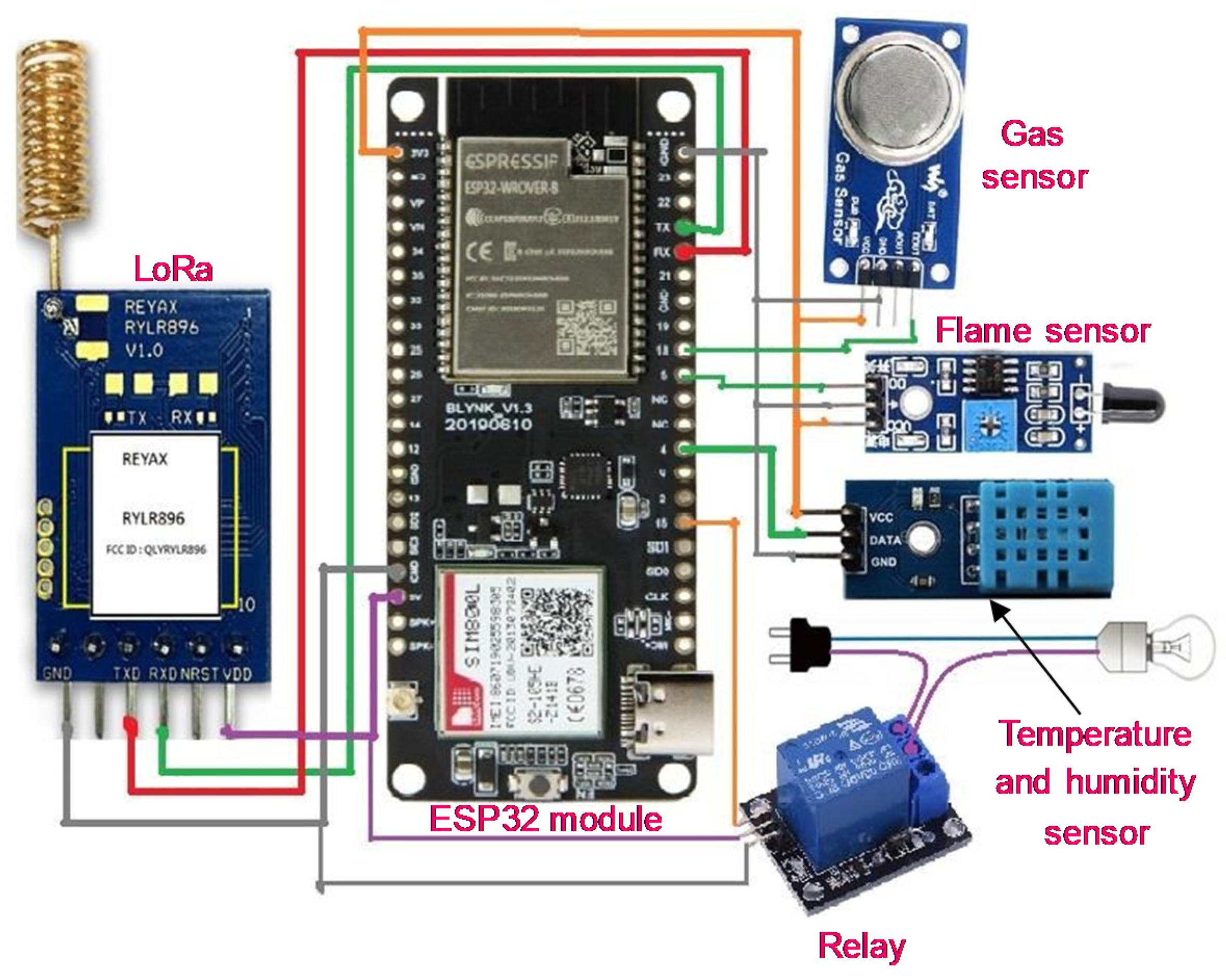
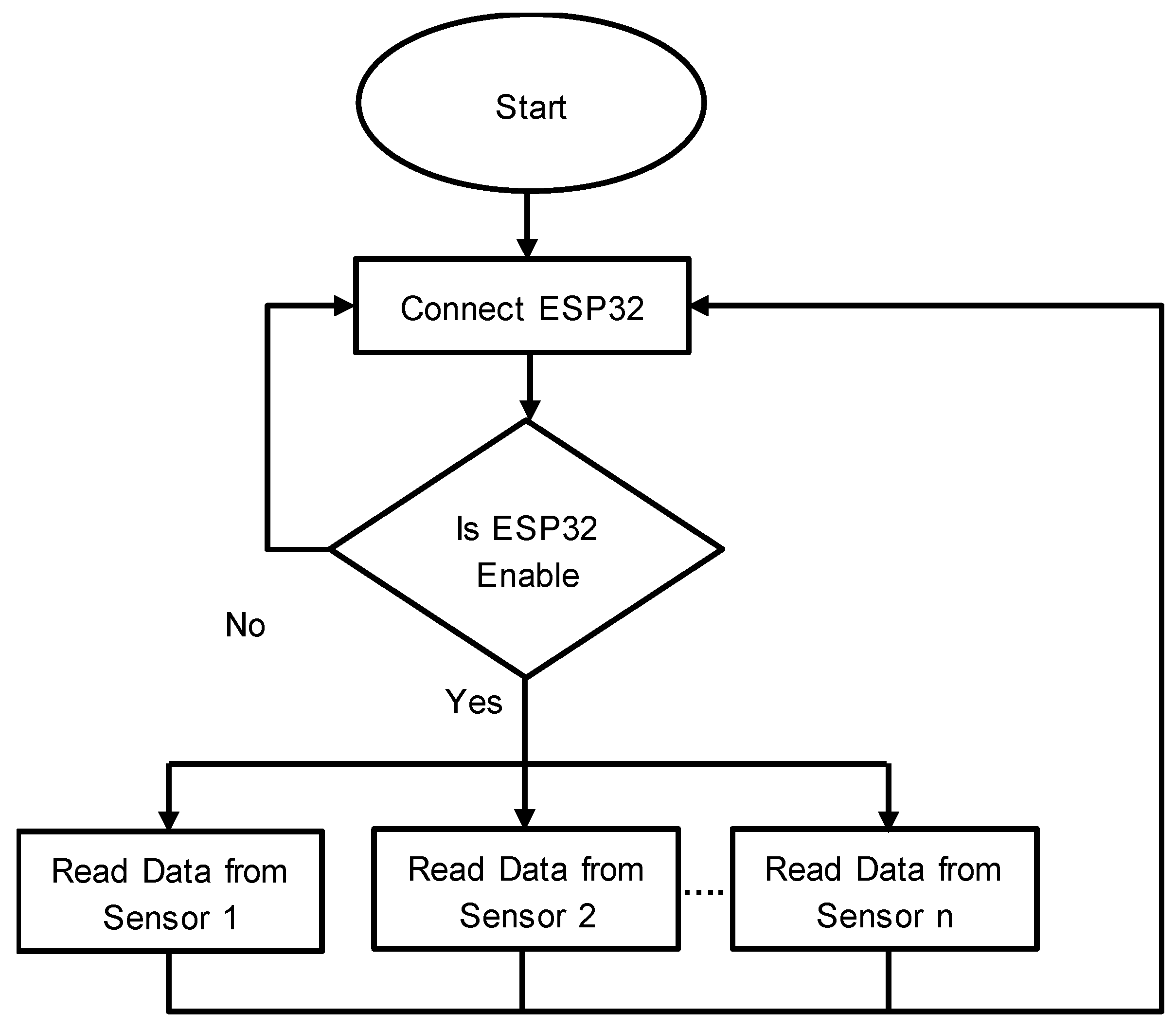
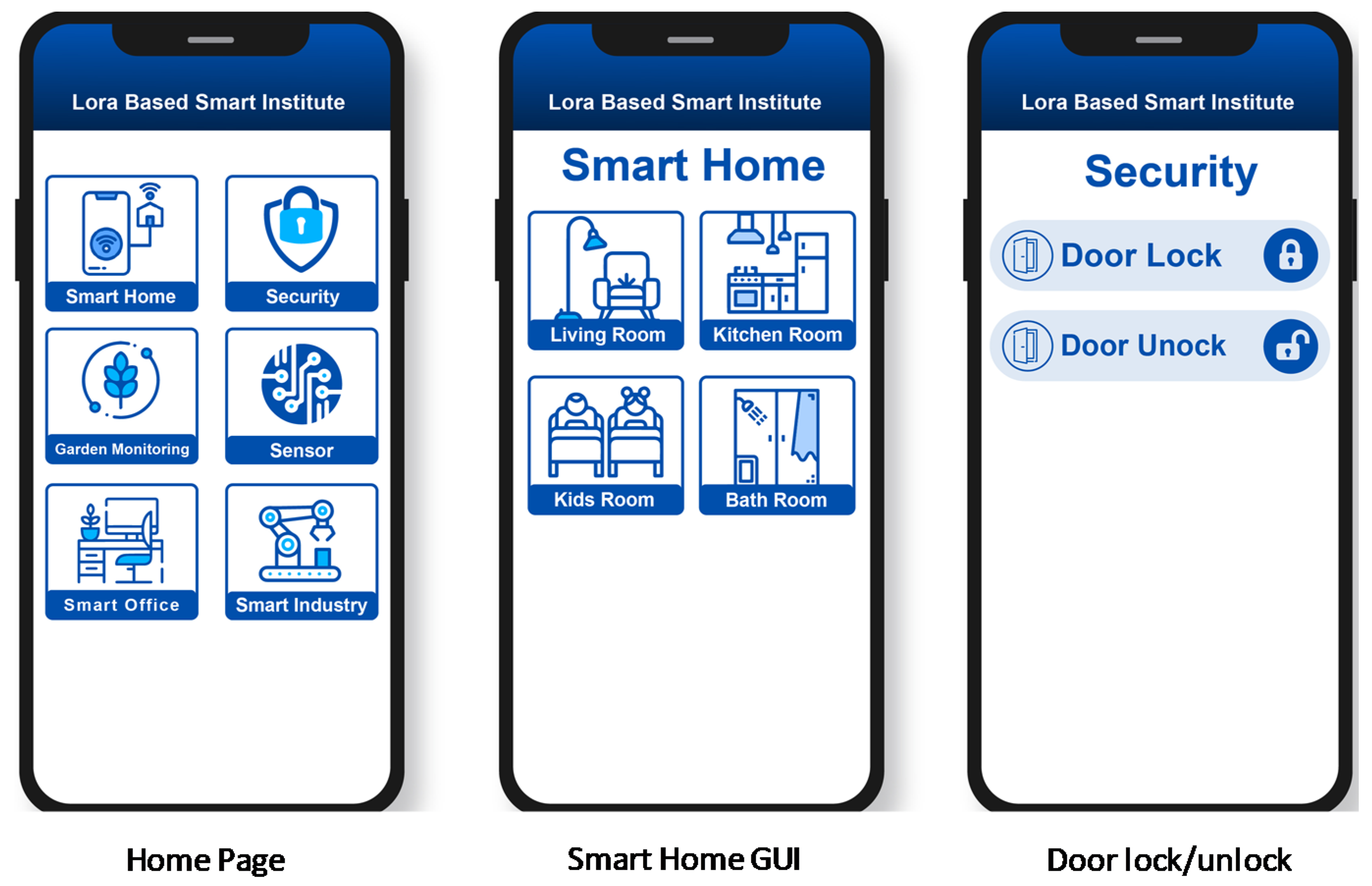
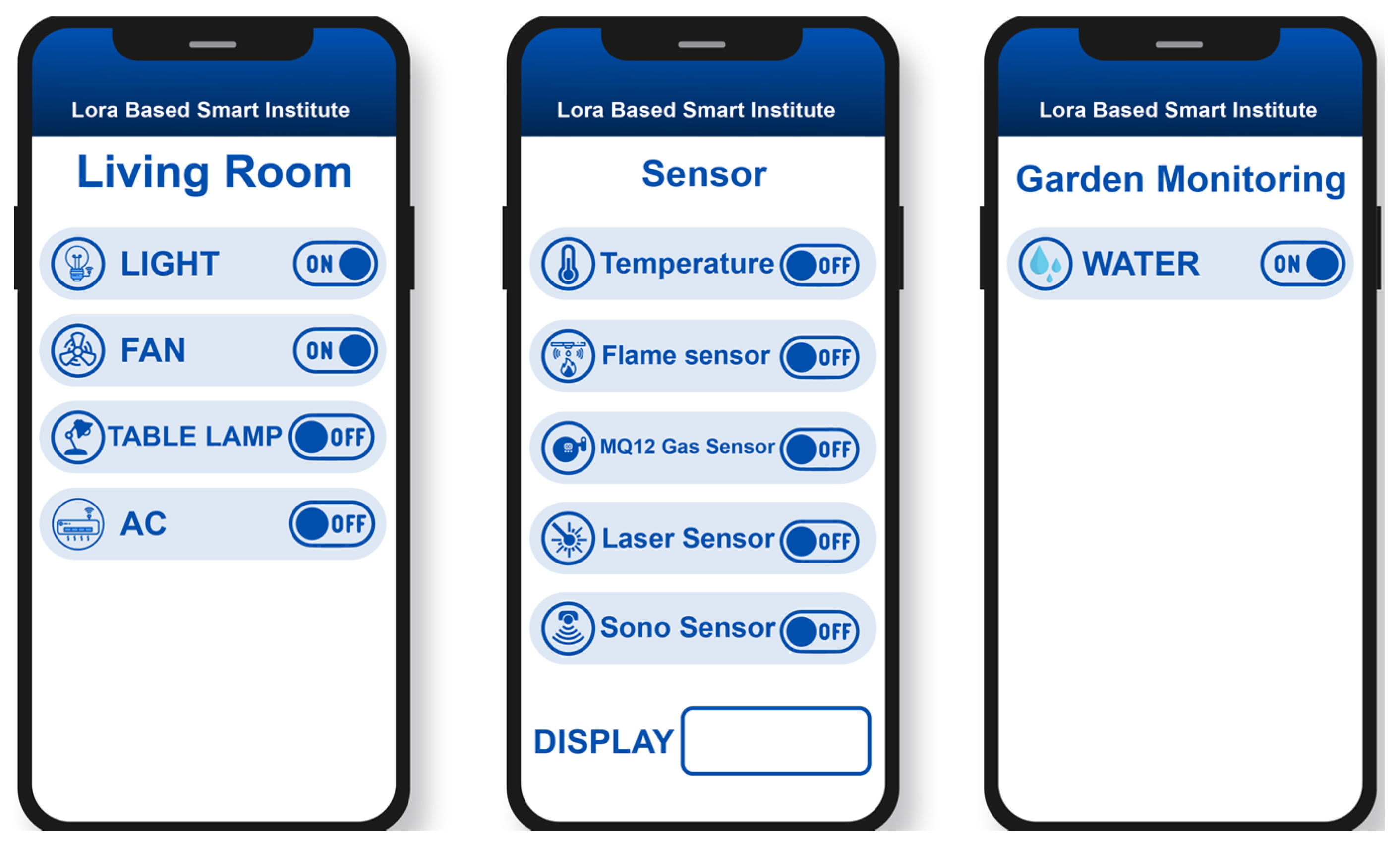
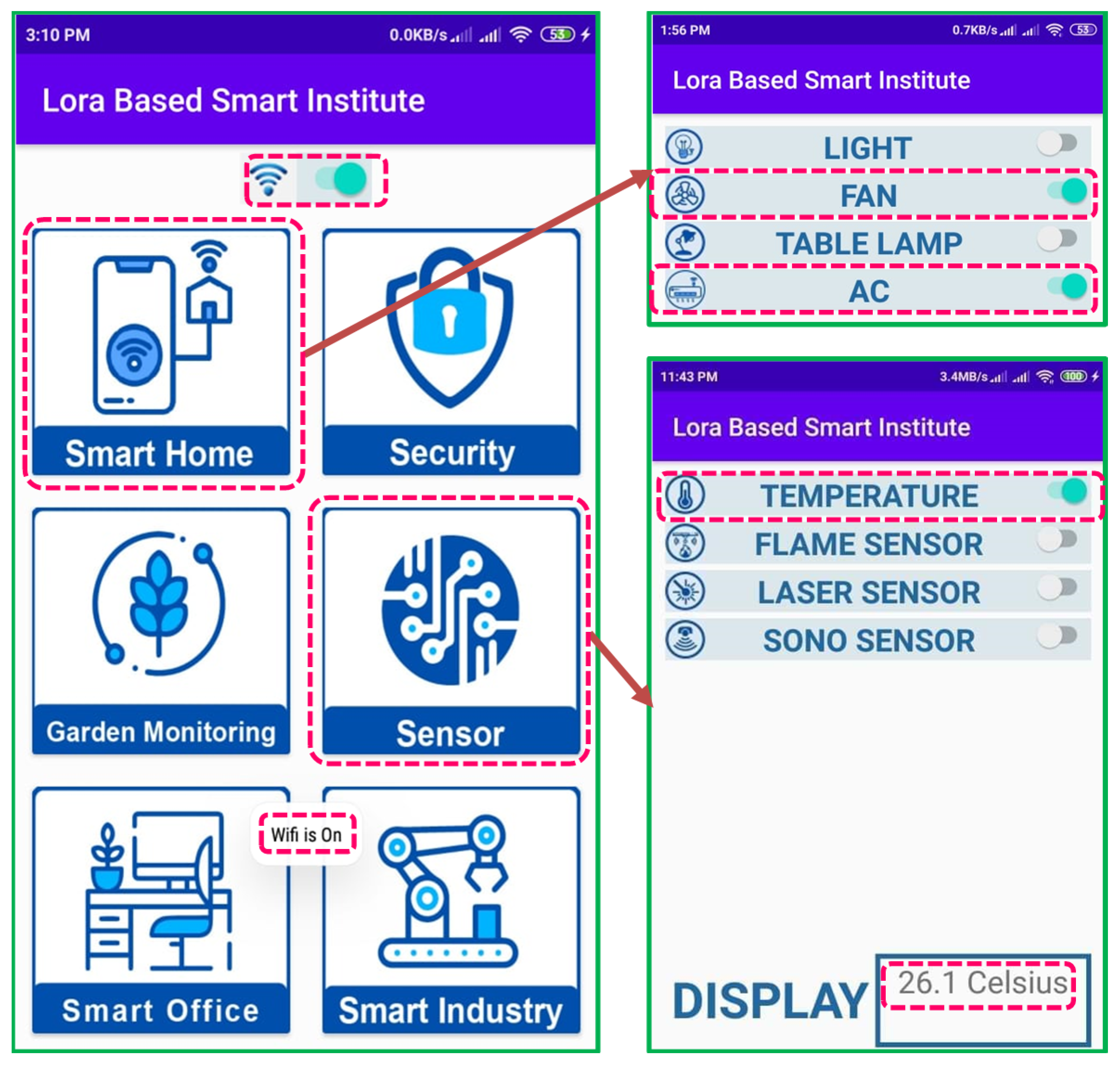
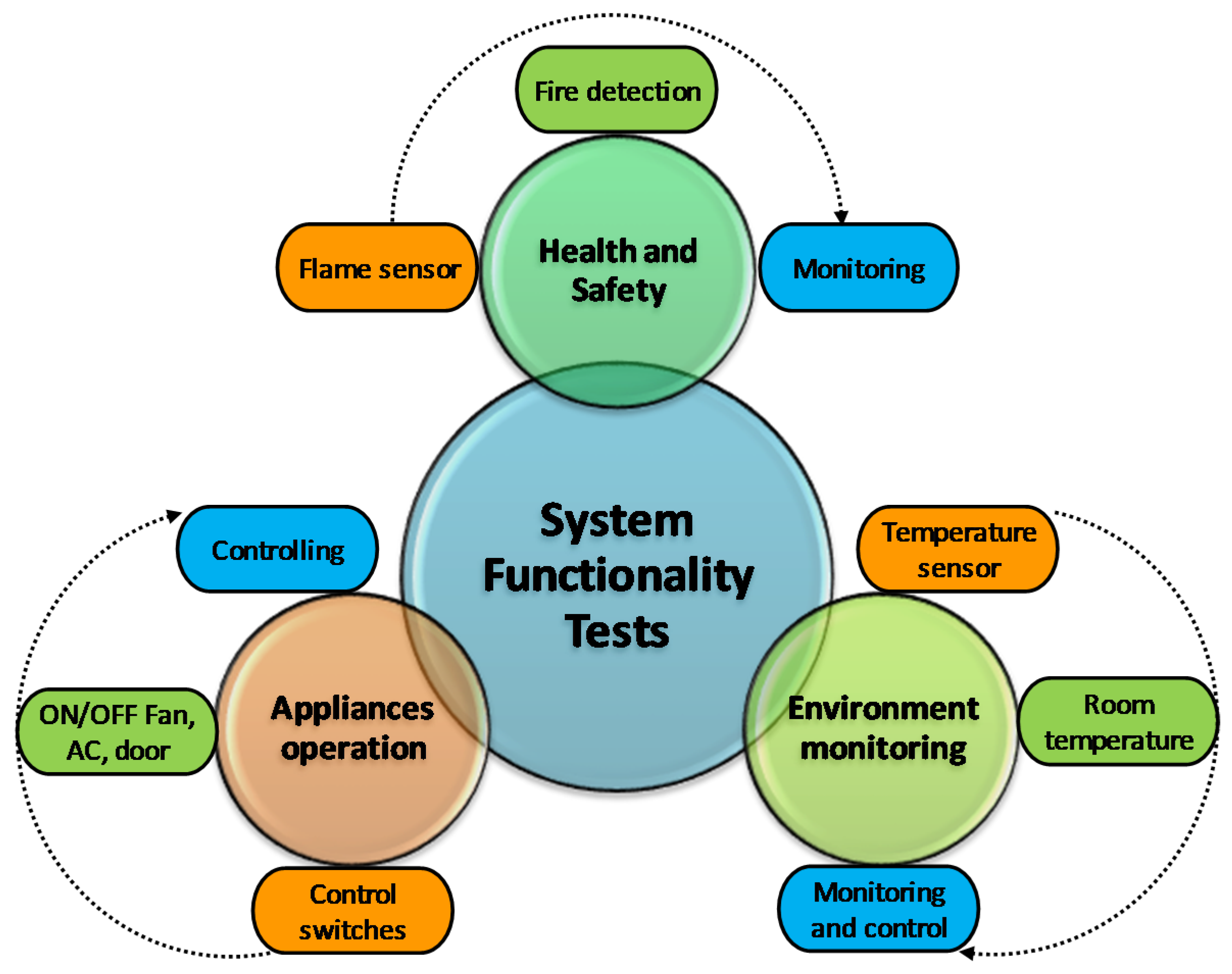
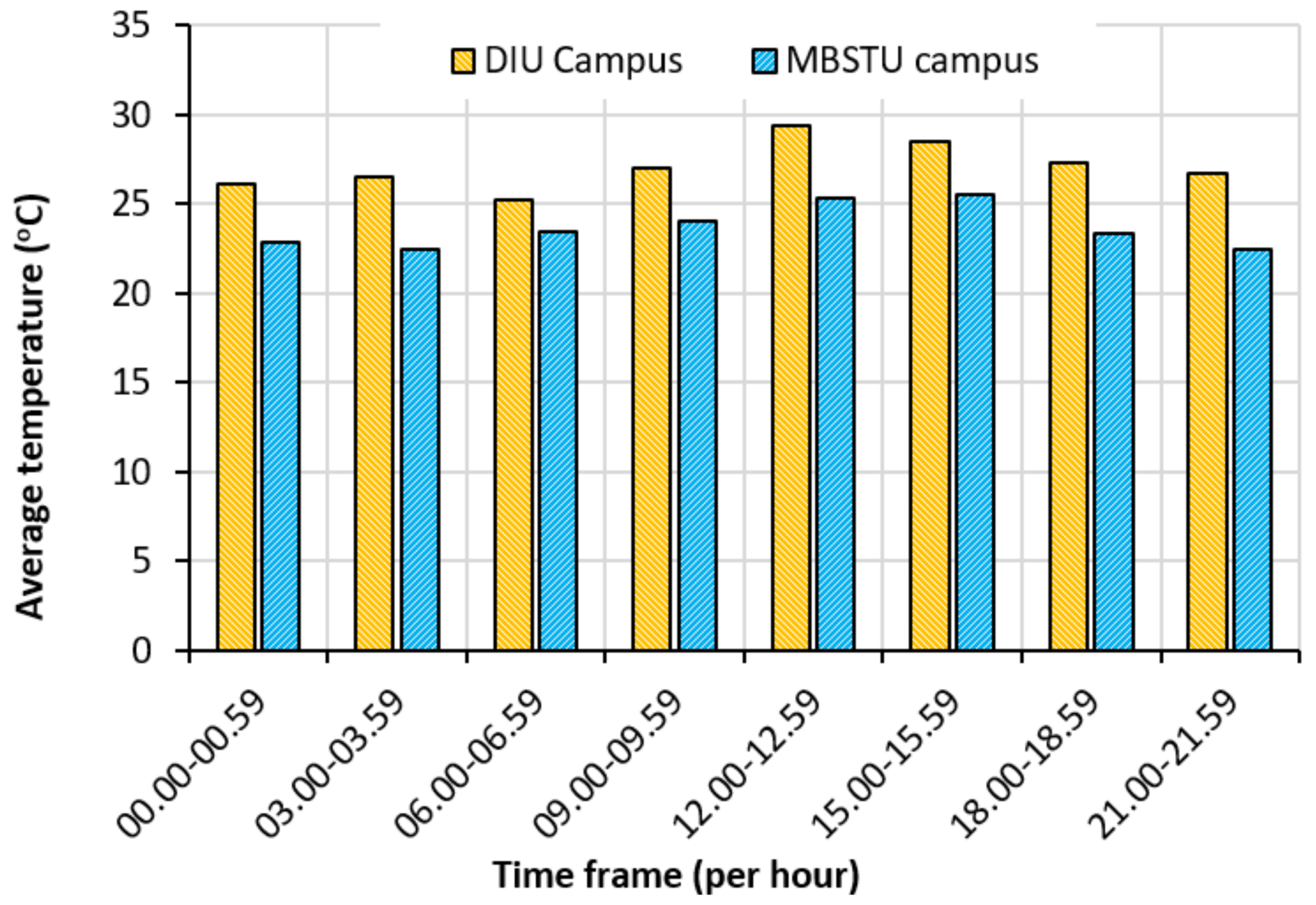
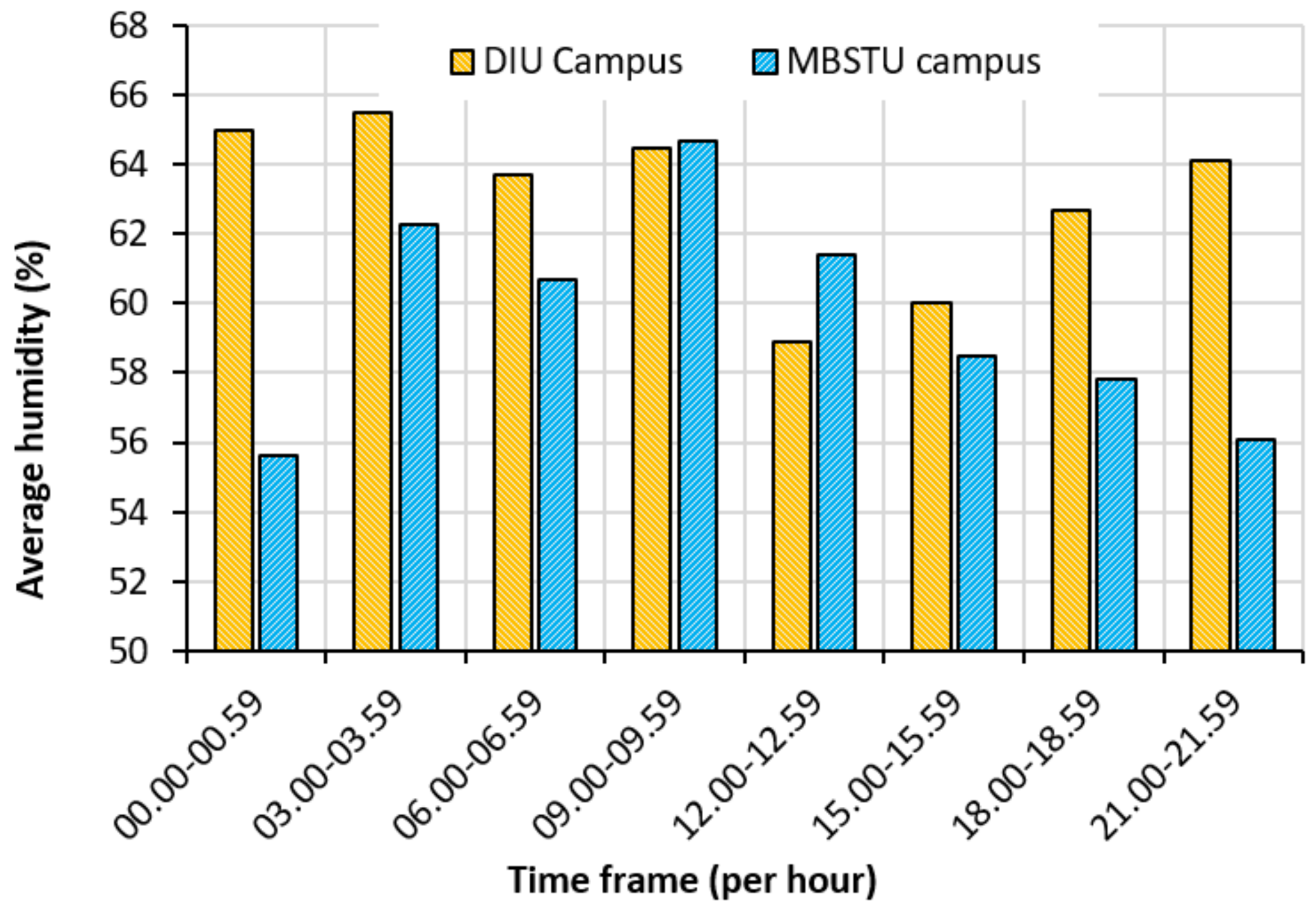
| List of Sensors | Sensor Description |
|---|---|
 DHT11 | Provides 16-bit serial data for both temperature and humidity of the installed environment. DHT11 sensor is used in the system to monitor room temperature and humidity. |
 Flame Sensor | Detects industrial heating or domestic firing. The flame sensor is used in the system to automatically monitor sudden firing. |
 MQ2 | MQ2 sensor is used in the system to detect H2, LPG, CH4, CO, Alcohol or Propane gas very rapidly. |
 Laser Sensor | Laser sensor is used to detect object and to measure the distance of the object. |
| Technology | Coverage Range, Power Consumption | Radio Band, Radio Spectrum | Transmit-Receive Data Size, Network Technology | Limitation/Advantage |
|---|---|---|---|---|
| Bluetooth [34] | 10–100 m, 15–30 mA per packet | UHF, 2.4–2.4835 GHz | 1–3 Mbps, PANs | Short range |
| Wi–Fi [35,36] | 50–100 m, 2 to 20 watts | UHF and SHF ISM, 2.4–5 GHz | 1–9608 Mbps, WLANs | Short Distance, High battery power |
| Zigbee [37] | 10–100 m, 150 mA | Unlicensed ISM bands, 2.4 GHz, 915,868 and 784 MHz | 20–250 kbps, WPANs | Short Distance, Maintenance cost too much |
| Sigfox [21,38] | 20–25 km, 78 mA | Licensed ISM bands, 868, 915 and 433 MHz | 100 bps (4–140 data/day), LPWAN | High module cost, High battery power |
| Proposed system (LoRa) | 10–20 km, 32 mA | Unlicensed ISM bands, 868, 915 and 433 MHz | 290 bps–50 kbps, LPWAN | Longer range, low battery power |
| SL. No. | Distance of Fire from Sensor (cm) | Response Time (Sec) | Fire Detection |
|---|---|---|---|
| 1 | 15.24 | 0.55 | Yes |
| 2 | 30.48 | 0.5 | Yes |
| 3 | 45.72 | 0.75 | Yes |
| 4 | 60.96 | 0.10 | Yes |
| 5 | 68.58 | 0.22 | Yes |
| 6 | 76.2 | 0.53 | Yes |
| 7 | 83.82 | - | No |
| 8 | 80.772 | 0.65 | Yes |
| 9 | 83.82 | 0.55 | Yes |
| 10 | 91.44 | 0.75 | Yes |
| Appliances | ON/OPEN | OFF/CLOSE | ||||
|---|---|---|---|---|---|---|
| No. of Transmitted Signal | No. of Received Signal | No. of Signal Losses | No. of Transmitted Signal | No. of Received Signal | No. of Signal Losses | |
| Light | 100 | 93 | 7 | 100 | 95 | 5 |
| Fan | 100 | 89 | 11 | 100 | 94 | 6 |
| Door | 100 | 91 | 9 | 100 | 92 | 8 |
| Total | 300 | 273 | 27 | 300 | 281 | 19 |
Publisher’s Note: MDPI stays neutral with regard to jurisdictional claims in published maps and institutional affiliations. |
© 2021 by the authors. Licensee MDPI, Basel, Switzerland. This article is an open access article distributed under the terms and conditions of the Creative Commons Attribution (CC BY) license (http://creativecommons.org/licenses/by/4.0/).
Share and Cite
Nur-A-Alam; Ahsan, M.; Based, M.A.; Haider, J.; Rodrigues, E.M.G. Smart Monitoring and Controlling of Appliances Using LoRa Based IoT System. Designs 2021, 5, 17. https://doi.org/10.3390/designs5010017
Nur-A-Alam, Ahsan M, Based MA, Haider J, Rodrigues EMG. Smart Monitoring and Controlling of Appliances Using LoRa Based IoT System. Designs. 2021; 5(1):17. https://doi.org/10.3390/designs5010017
Chicago/Turabian StyleNur-A-Alam, Mominul Ahsan, Md. Abdul Based, Julfikar Haider, and Eduardo M. G. Rodrigues. 2021. "Smart Monitoring and Controlling of Appliances Using LoRa Based IoT System" Designs 5, no. 1: 17. https://doi.org/10.3390/designs5010017
APA StyleNur-A-Alam, Ahsan, M., Based, M. A., Haider, J., & Rodrigues, E. M. G. (2021). Smart Monitoring and Controlling of Appliances Using LoRa Based IoT System. Designs, 5(1), 17. https://doi.org/10.3390/designs5010017








